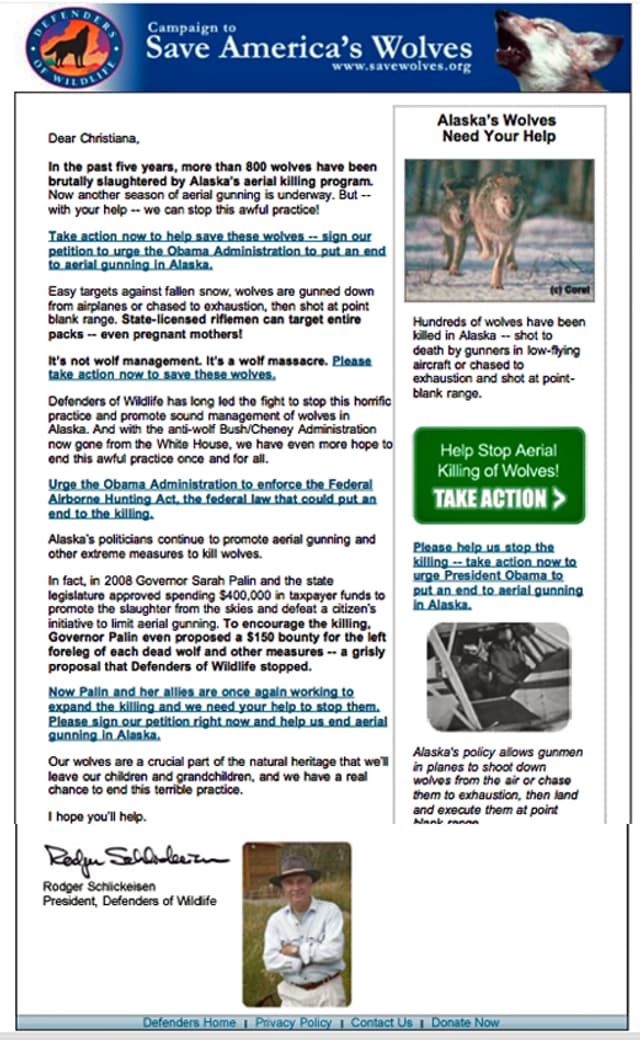Defenders of Wildlife: multi-channel direct marketing integration
- Exhibited by
- Christiana Stergiou
- Added
- October 26, 2010
- Medium of Communication
- Broadcast and television, direct mail, online, posters, telephone.
- Target Audience
- Awareness, individuals, planned gift, regular gift.
- Type of Charity
- Environmental/animals.
- Country of Origin
- USA.
- Date of first appearance
- 2008.
SOFII’s view
With more nonprofits engaging in online marketing, those that are coordinating their messages or campaigns across many channels, including email, web, social media, mail and the phone are standing out above the crowd. Those who do it well seem likely to build stronger relationships with their supporters and raise more money for their cause. In his Great and Good profile on SOFII, Mal Warwick predicts that the next big thing would be ‘truly integrated, multi-channel and multi-level fundraising’. Defenders of Wildlife are leaders in the field of online marketing and multi-channel integration, and are reaping the rewards as their donors respond to help them raise more money for their cause. Here we look at three separate Defenders’ campaigns to highlight some of the best multi-channel integrated marketing in the sector. This information was compiled from Jeff Regen’s presentation at the Resource Alliance’s first IFC online virtual conference.
Creator / originator
Jeff Regen, vice president of online marketing and communications and his in-house team at Defenders of Wildlife
Summary / objectives
Defenders of Wildlife is a highly effective conservation group in the USA. They send urgent and important messages, as well as carrying out campaigns and actions regularly throughout the year.
Defenders had to ensure that supporters received consistent, seamless messages about each campaign, regardless of whether the message was sent by email, mail, phone, or another channel. For those donors who received messages across many channels, for instance both mail and email, there was a strong need to have consistent and reinforced messages. This would make sure that donors knew exactly what the organisation was asking them for, and just how important that message was. It would also create many opportunities for donors to respond to that call for action.
The overall objective was to increase gross and net revenue through increasing the retention and value of donors.
Background
In any organisation, there can be a tendency towards ‘silos’, which means that different parts of fundraising act in isolation, without thinking how their actions may affect other areas. For example, an organisation may send out a direct mail appeal asking donors to do one thing, and an email appeal at roughly the same time asking them to do something else. Then there may be something altogether different on the main page of the website. And donors who telephone the organisation to respond may find that the staff member they’re talking to has no idea what is going on.
Those donors who get these mixed pieces of communication get very different messages, in effect diluting the strength of each ask; the result may be that the donor is more likely to take no action at all. Integration, or multi-channel marketing, is the opposite of silos.
In 2008, Defenders embarked on a revitalised fundraising strategy, eschewing silos and moving to a new way, the keystone of which was ‘integration’. This meant that donor communications were integrated across three main channels: direct mail, email/web and phone.
Special characteristics
Here we focus on three key campaigns that Jeff presented at the IFC online conference.
The aerial hunting/wolf killing campaign
The rise of Sarah Palin to the Republican Vice Presidential candidate triggered a tidal wave of phone calls to the Defenders’ office. Palin had a disgraceful track record on environmental issues, including being a supporter of the aerial hunting and killing of wolves.
Defenders immediately took action. The online and membership teams worked together to develop a ‘home-made’ 60-second television commercial and later developed three additional commercials. The first commercial went directly to supporters in an email campaign and generated over 130,000 views on YouTube. The ask on the emails was tied to the cost of a 30-second ad ($200) and they received more than 900 $200+ donations.
The campaign was Defenders’ most successful , ever, raising $1.3 million from six email campaigns, as well as from traffic to their website that was generated by press coverage. The membership call centre staff were briefed and primed to handle incoming calls and an additional $150,000 was raised from donors calling directly into the call centre.
Further integration was in place, this time with their donor development team, to ensure that donors who gave $1,000 or more immediately received a personal email from the president of Defenders. As a result, Ashley Judd, a well-known American singer and actress, who had given a major donation to the campaign, became a board member and featured in subsequent television commercials relating to the campaign.
Defenders also held a conference call and invited the 900 donors who had given $200 or more to attend. While only 20 attended, it is helping them build a core of major supporters.
Defenders also attempted a telephone fundraising campaign to their best donors to seek donations to the campaign, but this was less successful: people hadn’t actually seen the ad, and it was hard to get the impact across in a telephone conversation. In addition the global financial crisis had just hit and, according to Jeff Regen, this may have influenced donors not to give.
Defenders are also having some success with converting donors who gave to the campaign to regular monthly givers.
Annual renewal
Defenders of Wildlife is a membership-based organisation. Each year, Defenders send their members a reminder once a month until they renew their membership. This is an approach taken by many nonprofits in North America.
Over the first eight months, Defenders send a direct mail piece and a companion email, each month, asking members to renew. They personalise the ask amounts based on each donor’s highest personal contribution.
Defenders ensure the email and web landing page are consistent, so that when a donor clicks a link on the email it clicks through to a complementary web page. Furthermore, the companion email content can often update more recent events, compared to the longer development times required for direct mail pieces. Therefore, when necessary, the email becomes an extension of the direct mail piece.
See the timeline for the mail and email schedule for Defenders’ 2008 membership renewal campaign.
Membership card vote
All members of Defenders of Wildlife receive a membership card. Typically it has an image of a beautiful wolf (Defenders’ logo). In July 2008, Defenders invited members and supporters to go online to vote for their favourite of three images. The winning image was placed on that year’s membership card.
Defenders timed this to promote early memberships, so that members could renew and vote at the same time. They sent two different communications – one to existing members that encouraged them to renew early; and one to e-supporters (non-financial members) asking them to vote and, once they had voted, asking them to become members.
Over 55,000 supporters responded and voted. The campaign raised $130,000 by email and resulted in 2000 new donors.
For Defenders, this was not an overly successful campaign. The real value was that it involved people and built a closer relationship with their supporters. It is a great example of involving supporters by asking them to do things other than donate money. This type of ask is often called a ‘low-bar ask’.
Defenders have a range of ‘high-bar asks’, such as asking for a donation, or for membership renewal. However, throughout the year they include a number of low-bar asks, such as the membership card vote, completing a survey, or writing to a member of congress. These low-bar asks, which are much softer than asking for a donation or membership, keep donors involved and create a connection between the donor and the organisation. They often result in important campaigning action by the donor.
Influence / impact
Part of the mission of Defenders of Wildlife is to promote the election of politicians sympathetic to their cause. The funds raised went to campaign against the election of McCain for President and Palin for Vice President during the 2008 presidential election. Furthermore, Defenders placed press ads in swing states during that election (those states with a narrow Republican majority that could swing across to being Democrat). An Obama victory went to all targeted swing states bar one.
Details
For membership renewals, Defenders have tested sending a companion email before and after the the mail piece. They found it was significantly better for the email to be sent after the mail piece has arrived.
Results
Overall, donors who give in many ways, such as through both email and mail are three times more valuable, each year, than those donors who give in just one way, and they’re more likely to renew in the next year.
There has been a $20 increase in the annual value of donors who have email addresses, compared to those who don’t.
Merits
With online marketing becoming increasingly prevalent, many nonprofits have an opportunity to look holistically across all their donor communications channels. Defenders of Wildlife are leaders in the field. And if your organisation does it well, you’ll raise more money for your cause and build stronger and longer relationships with your supporters.
Other relevant information
Jeff Regen’s advice for encouraging integration (internally):
- Make communication between your teams easy.
- Don’t worry about which department gets the money, just worry about how to raise more of it.
- Put in place coordination meetings across your various teams or departments.
- Collaborate on budget priorities.
- Share costs (database, etc).
Defenders currently have 530,000 members (donors), 160,000 of which have supplied a valid email address. They also have 800,000 e-supporters (including members). They have a nine-person online marketing and communications team and a 14-person membership, operations and database team.
Final notes
SOFII would like to thank the Resource Alliance for providing SOFII’s access to the 2009 IFC online conference, where Jeff Regan of Defenders of Wildlife presented this valuable information.
 View original image
View original image
 View original image
View original image

 View original image
View original image


















